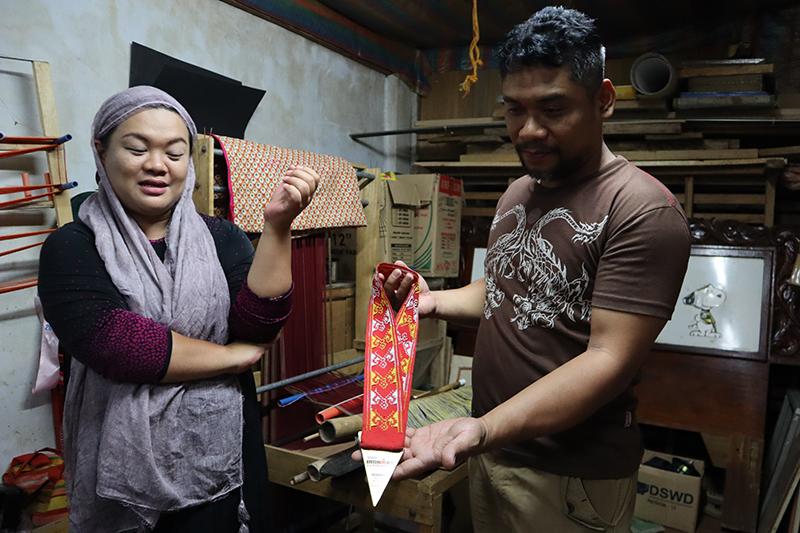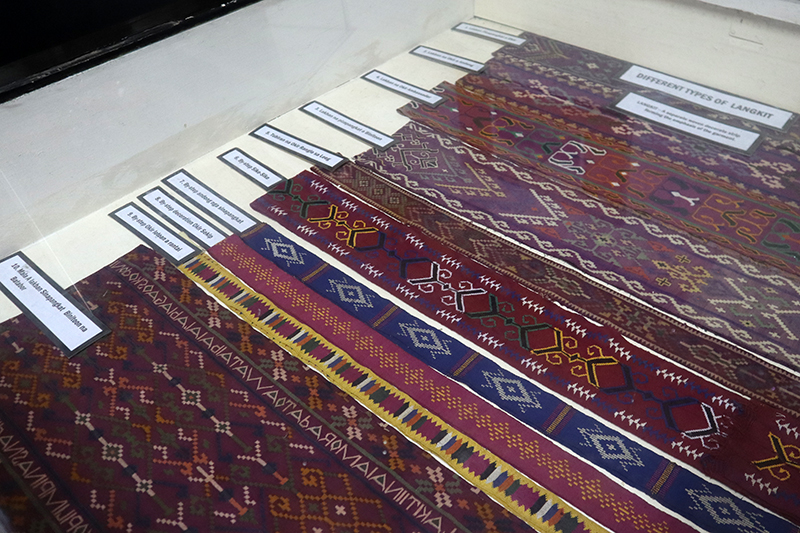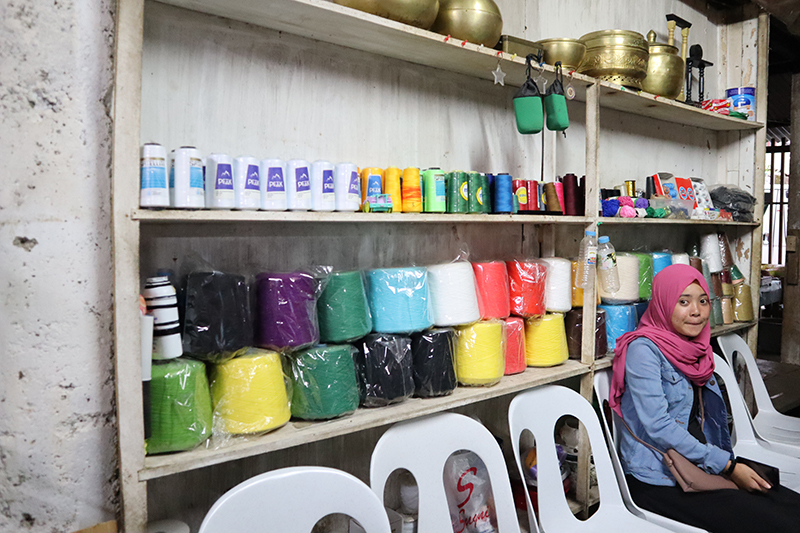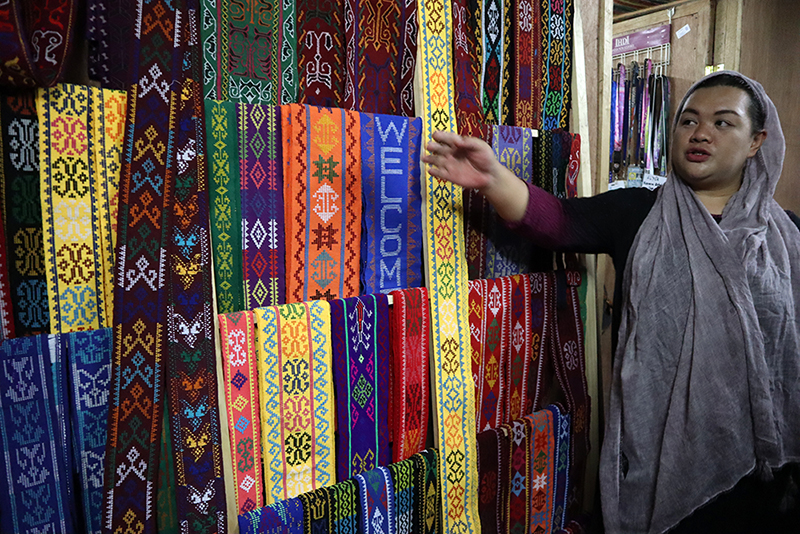Weaving hope in Marawi | ABS-CBN

Welcome, Kapamilya! We use cookies to improve your browsing experience. Continuing to use this site means you agree to our use of cookies. Tell me more!
Weaving hope in Marawi
Weaving hope in Marawi
Kara Santos
Published Aug 31, 2018 05:51 AM PHT
For athletes, medals are highly collectible items, a token of victory after completing a race or sporting event. One of the prizes this year for finishers of the first full-distance Ironman race in the Philippines held in Subic last June was the “Alab ng Puso” medal created by sculptor Daniel De La Cruz.
For athletes, medals are highly collectible items, a token of victory after completing a race or sporting event. One of the prizes this year for finishers of the first full-distance Ironman race in the Philippines held in Subic last June was the “Alab ng Puso” medal created by sculptor Daniel De La Cruz.
But even before triathletes crossed the finish line, the first to receive the medal was a group of Maranao weavers whose homes and livelihoods were destroyed during the Marawi siege.
But even before triathletes crossed the finish line, the first to receive the medal was a group of Maranao weavers whose homes and livelihoods were destroyed during the Marawi siege.
Salika Maguindanao-Samad and Jardin Samad of The Maranao Collectibles are at the forefront of the group of evacuees from Marawi City who made the medal ribbons.
Salika Maguindanao-Samad and Jardin Samad of The Maranao Collectibles are at the forefront of the group of evacuees from Marawi City who made the medal ribbons.
The medals feature langkit or traditional Maranao weaving with okir patterns. These handwoven decorative strips of varying width are traditionally handsewn into the landap or ceremonial malong. Their group hopes to creatively revive the vanishing tradition of weaving by reaching a wider market and harnessing social media to promote the products.
The medals feature langkit or traditional Maranao weaving with okir patterns. These handwoven decorative strips of varying width are traditionally handsewn into the landap or ceremonial malong. Their group hopes to creatively revive the vanishing tradition of weaving by reaching a wider market and harnessing social media to promote the products.
ADVERTISEMENT
The Ironman triathlon medal, which came in three colors with different patterns to represent the disciplines of swimming, biking and runnning, was their big break.
The Ironman triathlon medal, which came in three colors with different patterns to represent the disciplines of swimming, biking and runnning, was their big break.
The langkit was chosen from 15 different weaves from tribes in the Philippines collected by the Dream Project, a partner organization of the Ironman triathlon, with the final design handpicked by De la Cruz who designed the pendant.
The langkit was chosen from 15 different weaves from tribes in the Philippines collected by the Dream Project, a partner organization of the Ironman triathlon, with the final design handpicked by De la Cruz who designed the pendant.
“Sabi sa amin, don’t think na napili 'yung design niyo because you’re IDPs and you need it. Napili 'yan because it’s really beautiful and very unique, so you should be proud,” said Salika.
“Sabi sa amin, don’t think na napili 'yung design niyo because you’re IDPs and you need it. Napili 'yan because it’s really beautiful and very unique, so you should be proud,” said Salika.
(We were told that our design was picked not because of our situation of being displaced and they pity us. They picked it because it’s really beautiful and unique, something we can be proud of.)
(We were told that our design was picked not because of our situation of being displaced and they pity us. They picked it because it’s really beautiful and unique, something we can be proud of.)
It was no easy feat to finish the order for 1,200 medals in just 4 months, since their production materials were destroyed. Majority of the weavers they tapped were fellow evacuees who lost everything during the conflict.
It was no easy feat to finish the order for 1,200 medals in just 4 months, since their production materials were destroyed. Majority of the weavers they tapped were fellow evacuees who lost everything during the conflict.
“Pare-pareho kaming nag-start from zero. 'Yung ibang weavers, wala rin gamit. For more than one year ba naman na walang tao dito. 'Yung iba walang pambili ng thread,” said Salika.
“Pare-pareho kaming nag-start from zero. 'Yung ibang weavers, wala rin gamit. For more than one year ba naman na walang tao dito. 'Yung iba walang pambili ng thread,” said Salika.
(We were all starting from zero. Some of our weavers lost all their materials including handlooms for weaving. We couldn’t return for more than a year. The others didn’t have money to buy thread.)
(We were all starting from zero. Some of our weavers lost all their materials including handlooms for weaving. We couldn’t return for more than a year. The others didn’t have money to buy thread.)
Production was slow due to the intricate designs and patterns. It usually takes a weaver one day to weave one meter of the langkit. They also had to make their own handlooms using any material they could get their hands on just so that weavers would have something to use while in evacuation centers and tent cities during the height of the Marawi siege.
Production was slow due to the intricate designs and patterns. It usually takes a weaver one day to weave one meter of the langkit. They also had to make their own handlooms using any material they could get their hands on just so that weavers would have something to use while in evacuation centers and tent cities during the height of the Marawi siege.
“Daig pa namin 'yung tumakbo ng triathlon sa sobrang hirap ng pinagdaanan namin. Umulan man o bumagyo, pinupuntahan namin yung mga kasama namin para matapos yung order. Pero pinatunayan talaga namin na kahit may gyera, ginagawa namin ito,” said Jardin.
“Daig pa namin 'yung tumakbo ng triathlon sa sobrang hirap ng pinagdaanan namin. Umulan man o bumagyo, pinupuntahan namin yung mga kasama namin para matapos yung order. Pero pinatunayan talaga namin na kahit may gyera, ginagawa namin ito,” said Jardin.
(What we achieved is more than running a triathlon with all the challenges we overcame. Even through rain and typhoons, we would go to our companions in other evacuation centers just to complete the order.)
(What we achieved is more than running a triathlon with all the challenges we overcame. Even through rain and typhoons, we would go to our companions in other evacuation centers just to complete the order.)
The Maranao Collectibles by Salika & Jardin is working in partnership with KulturAKO, a livelihood training project for younger community members to learn the art of weaving, which in itself is vanishing. They aim to train students and out-of-school youth on traditional weaving and help market products through social media.
The Maranao Collectibles by Salika & Jardin is working in partnership with KulturAKO, a livelihood training project for younger community members to learn the art of weaving, which in itself is vanishing. They aim to train students and out-of-school youth on traditional weaving and help market products through social media.
KulturAKO is a program under #ForMindanao, a program of the U.S Embassy, Manila and Naawan HELPS Communities that provides funding and technical support to locally led projects that mobilize communities in Mindanao
KulturAKO is a program under #ForMindanao, a program of the U.S Embassy, Manila and Naawan HELPS Communities that provides funding and technical support to locally led projects that mobilize communities in Mindanao
“We have to make it sustainable. If there’s a constant market, more people in the community will be encouraged to take up weaving,” said Salika.
“We have to make it sustainable. If there’s a constant market, more people in the community will be encouraged to take up weaving,” said Salika.
Their group is also exploring creative and modern uses of the textile for accessories, souvenirs, nametags, lanyards and the like. They’ve gotten some orders from travel agencies and are open to working with bag and clothing designers.
Their group is also exploring creative and modern uses of the textile for accessories, souvenirs, nametags, lanyards and the like. They’ve gotten some orders from travel agencies and are open to working with bag and clothing designers.
They are reaching out to a wider market online through social media, which is another challenge given the unreliable internet situation in Marawi.
They are reaching out to a wider market online through social media, which is another challenge given the unreliable internet situation in Marawi.
“We want to show na, IDPs man kami, gumagawa kami ng paraan mabuhay. Hindi kami umaasa lang sa relief goods o sa bigay ng gobyerno,” said Salika.
“We want to show na, IDPs man kami, gumagawa kami ng paraan mabuhay. Hindi kami umaasa lang sa relief goods o sa bigay ng gobyerno,” said Salika.
(We want to show that even though we are internally displaced - we are finding ways to get by. We are not just relying on relief goods or dole-outs from the government.)
(We want to show that even though we are internally displaced - we are finding ways to get by. We are not just relying on relief goods or dole-outs from the government.)
Salika believes that their langkit can tell the story of the Maranao people to different parts of the world.
Salika believes that their langkit can tell the story of the Maranao people to different parts of the world.
“Gusto namin umabot yung products namin even outside the country, na makilala siya na wow this is different from other weaves,” said Salika.
“Gusto namin umabot yung products namin even outside the country, na makilala siya na wow this is different from other weaves,” said Salika.
(We want our products to reach outside the country and be known for being unique and different from other weaves.)
(We want our products to reach outside the country and be known for being unique and different from other weaves.)
“Gusto din namin mabura sa isip ng mga tao na 'pag sinabi mo Maranao - sa ngayon - terrorista. Gusto namin ipakita yung Maranao as artist. Meron din kaming kultura na pwedeng ipagmalaki,” added Jardin.
“Gusto din namin mabura sa isip ng mga tao na 'pag sinabi mo Maranao - sa ngayon - terrorista. Gusto namin ipakita yung Maranao as artist. Meron din kaming kultura na pwedeng ipagmalaki,” added Jardin.
(We want to remove the stigma in the mind of people when you say Maranao - they associate it with terrorists. We want to show the Maranao as artists. We have a culture we can be proud of.)
(We want to remove the stigma in the mind of people when you say Maranao - they associate it with terrorists. We want to show the Maranao as artists. We have a culture we can be proud of.)
ADVERTISEMENT
ADVERTISEMENT







